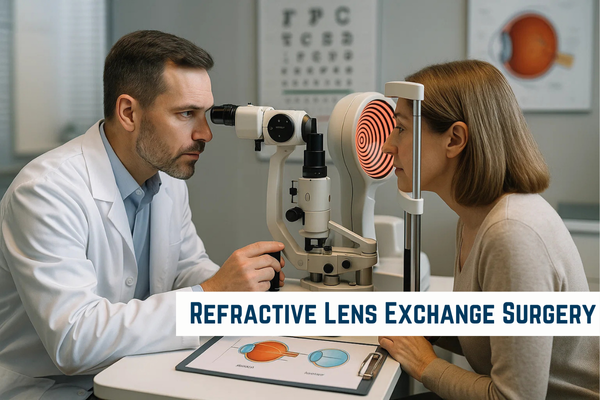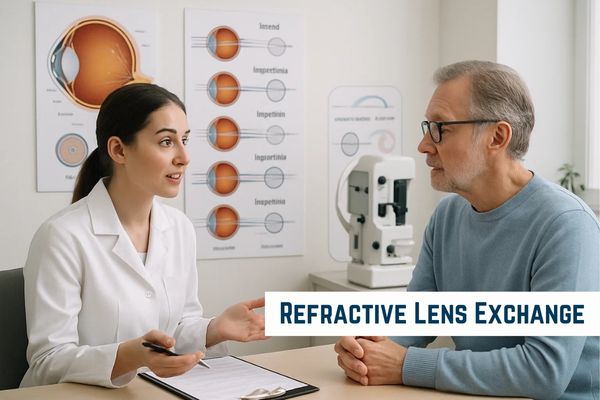Refractive lens exchange (RLE), also known as lens replacement surgery, has become an increasingly popular solution for those seeking to improve their vision and reduce dependence on corrective eyewear. Whether it’s for patients struggling with presbyopia or refractive errors like myopia, hyperopia or astigmatism, RLE provides an advanced method for vision correction. However, just like any medical procedure, the success of RLE largely depends on proper patient selection. In this article, we will discuss the best practices and guidelines for choosing suitable candidates for refractive lens exchange surgery.

What is Refractive Lens Exchange Surgery?
How Refractive Lens Exchange Works?
The procedure begins with the surgeon making a small incision in the eye to remove the natural lens. An IOL, selected based on the patient’s needs, is then implanted into the eye. The artificial lens can be customized to address various vision issues, providing long-lasting results and improving the overall quality of life for patients. The surgery is typically quick, minimally invasive and performed under local anesthesia.
Why is Patient Selection Critical for Refractive Lens Exchange Surgery?
Selecting the right candidates for refractive lens exchange surgery is crucial because not everyone is an ideal fit for the procedure. Patients who are poorly selected may experience suboptimal results or complications post-surgery. Proper patient evaluation ensures the best possible outcomes by considering the individual’s overall eye health, lifestyle and expectations.
Factors Influencing Successful Outcomes
Testimonials
“First Class Professional Care & Advice”
What Are the Key Patient Selection Criteria for Refractive Lens Exchange Surgery?
Age and Refractive Stability
Typically, candidates for refractive lens exchange are individuals over the age of 40, as this is the age when presbyopia begins to affect vision. However, patients in their 50s or 60s are often ideal candidates for the procedure, as their vision may have stabilized. Patients under 40 may still experience changes in their vision and therefore, may not be the best candidates for lens replacement surgery.
Patients with stable refractive errors are more likely to achieve successful outcomes. Instability in the refractive error could lead to less predictable results.
Refractive Errors
RLE is commonly recommended for patients with high refractive errors that cannot be corrected with glasses or contact lenses. This includes individuals with severe myopia, hyperopia or astigmatism. RLE can also benefit those who have developed presbyopia, a condition where the eye loses the ability to focus on close objects.
The type and extent of refractive error play an important role in determining whether lens replacement surgery is appropriate. Each patient’s unique eye characteristics help determine the most suitable IOL options and surgical approach.
Eye Health and History
Candidates should have generally healthy eyes, free from conditions like glaucoma, diabetic retinopathy or macular degeneration, which may complicate the surgery or lead to poor outcomes. The cornea, retina and optic nerve must be in good health to ensure that the eye can handle the surgery and support the recovery process.
For patients with previous eye surgeries, special considerations must be made to ensure that the RLE procedure will not interfere with the outcomes of the previous treatment. It’s essential to evaluate whether the eye has healed appropriately from prior procedures.
Client Speaks
“Extremely gentle, professional and informative, Could not wish for more “
How to Evaluate the Ideal Candidate for Refractive Lens Exchange Surgery?
Comprehensive Eye Examination
A comprehensive eye exam is the first step in determining whether a patient is suitable for RLE. This exam typically includes:
- Refraction Test: To assess the degree of refractive errors (myopia, hyperopia, astigmatism).
- Corneal Thickness and Shape: To ensure that the cornea is thick enough to support surgery and not at risk for complications.
- Ocular Health: An examination of the retina, macula and optic nerve to rule out any underlying conditions that may affect the surgery.
- Pupil Dilation: To check for any signs of cataract development or other issues that may affect vision.
Personalized Consultation
When Should Refractive Lens Exchange Surgery Be Considered?

Indications for Refractive Lens Exchange
- Age-Related Presbyopia: Patients over the age of 40 who are struggling with reading or near vision may benefit from RLE.
- High Refractive Errors: Severe myopia or hyperopia that cannot be corrected with standard vision correction methods may make RLE a good choice.
- Desire for Permanent Vision Correction: Patients seeking long-term freedom from glasses or contacts often turn to RLE as an ideal solution.
Situations Where RLE is Not Recommended
RLE is typically not recommended for individuals under the age of 40 unless there are exceptional circumstances. It is also contraindicated in patients with certain medical conditions such as uncontrolled diabetes, active eye diseases or severe dry eye syndrome. Additionally, those with unrealistic expectations regarding vision outcomes may not be suitable candidates.
Conclusion
Refractive lens exchange surgery can offer life-changing benefits for patients looking to improve their vision. However, the procedure is not suitable for everyone. Careful patient selection is essential for ensuring optimal results and minimizing risks. By considering factors such as age, refractive error, eye health and patient expectations, healthcare professionals can determine the best candidates for RLE and provide them with personalized treatment plans.
For patients looking to explore refractive lens exchange surgery, it is vital to seek expert consultation and comprehensive evaluation before proceeding with the procedure. By following the established best practices and guidelines for patient selection, both patients and surgeons can ensure successful outcomes.
Frequently Asked Questions -Refractive Lens Exchange Surgery
Q1. What is the main reason for choosing refractive lens exchange surgery?
A. Refractive lens exchange surgery is typically chosen by individuals who have refractive errors such as myopia, hyperopia or presbyopia and are looking for a permanent solution to improve their vision and reduce their dependency on glasses or contact lenses.
Q2. How do I know if I'm a suitable candidate for refractive lens exchange surgery?
A. The best way to determine suitability is by having a comprehensive eye exam with an experienced surgeon. Factors like age, the stability of refractive errors and overall eye health will be evaluated to decide if you’re a candidate.
Q3. What types of lenses are used in refractive lens exchange surgery?
A. The most commonly used lenses are intraocular lenses (IOLs), which can be customized to treat specific refractive errors. There are different types, including monofocal, multifocal and toric IOLs.
Q4. Is refractive lens exchange surgery safe?
A. Yes, refractive lens exchange surgery is generally considered safe, with most patients experiencing significant improvements in their vision. However, like any surgery, it does come with some risks, which can be minimized by selecting the right candidates and using the latest technology.
Q5. How long does it take to recover from refractive lens exchange surgery?
A. Recovery time can vary, but most patients experience improved vision within a few days to weeks. Complete healing and stabilization may take up to a few months.
